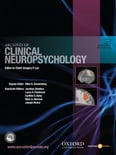Justice-involved men appear to represent a distinct neuropsychological population. This is the bottom line of a recently published article in Archives of Clinical Neuropsychology. Below is a summary of the research and findings as well as a translation of this research into practice.

Featured Article | Archives of Clinical Neuropsychology | 2017, Vol. 40, No. 2, 1-14
The Neuropsychological Assessment of Justice-Involved Men: Descriptive Analysis, Preliminary Data, and a Case for Group-Specific Norms
Authors
Casey LaDuke, Drexel University, University of Virginia Health System
David DeMatteo, Drexel University
Kirk Heilbrun, Drexel University
Jennifer Gallo, Drexel University
Thomas Swirsky-Sacchetti, Jefferson Medical College
Abstract
Objective: Neuropsychological expertise has played an increasing role in legal decision-making in criminal contexts. Valid neuropsychological evidence in criminal forensic contexts requires normative data that are representative of justice-involved individuals. Unfortunately, existing normative data appear unlikely to represent justice-involved individuals due to significant demographic and clinical factors specific to this population. As a result, the interpretation of neuropsychological performance with justice-involved individuals using existing normative data may increase the risk of inaccurate description, invalid clinical conceptualization, misdiagnosis of impairment, and misattribution of deficits in functional-legal capacities. The current study aimed to examine the use of neuropsychological assessment with justice-involved men.
Method: A sample of incarcerated men (N = 95) was assessed using a battery of demographic, clinical, and neuropsychological measures.
Results: Descriptive analyses showed the demographic and clinical diversity of justice-involved men. Inferential statistical analyses, effect size calculations, and clinical analyses demonstrated that a sample of justice-involved men performed significantly differently and was more impaired than commonly referenced normative samples across multiple measures of intellectual functioning, attention, verbal fluency, and executive functioning. Preliminary data are provided to aid the use of the selected neuropsychological measures with justice-involved men.
Conclusions: Justice-involved men appear to represent a distinct neuropsychological population. Group-specific normative data will be useful to help ensure that opinions about these individuals are relevant, valid, and admissible within legal decision-making in criminal contexts. The current data can guide future efforts to develop substantive normative data on neuropsychological measures likely to be used in the assessment of justice-involved men.
Keywords
Forensic neuropsychology, Assessment, Norms/normative studies, Head injury, Traumatic brain injury
Summary of the Research
“Neuropsychological assessment is a multidisciplinary practice with much potential to inform legal decision-making. Its role in civil proceedings has been recognized for some time, and it continues to be developed in criminal proceedings. Given the increasing prevalence of both neuropsychological and neuroscientific evidence in criminal legal cases, and the limitations of neuroscientific evidence to answer relevant criminal psycholegal questions, it is reasonable to assume neuropsychological expertise will continue to play an increasing role in criminal cases in the United States legal system” (p. 1).
“Justice-involved individuals appear to represent a distinct neuropsychological population that is not well described by current normative data. Applying existing, commonly used normative data to justice-involved individuals may therefore lead to inaccurate description of neurocognitive strengths and weaknesses, poor clinical conceptualization of impairment and treatment considerations, and invalid diagnosis. As a result, this practice does not appear to be fully consistent with relevant ethical guidance from the Ethical Principles of Psychologists and Code of Conduct, or the Guidelines on Multicultural Education, Training, Research, Practice, and Organizational Change for Psychologists. Nor does this practice appear fully consistent with relevant practice guidelines or standards for the admissibility of evidence in criminal legal decision-making, particularly related to the concepts of legal materiality (i.e., the nexus between the neuropsychological evidence and the psycholegal question before the court), empirical fit (i.e., the extent to which neuropsychological practice can be applied within the criminal justice setting), and probative value (i.e., whether the neuropsychological evidence makes a fact at issue in the case more or less likely, typically based on the validity of its underlying procedures” (p. 2).
“The goal of the current study was to examine the use of neuropsychological assessment in a general population of justice involved men. To that end, clinical and neuropsychological descriptions of a sample of justice-involved men are presented. This sample is then compared against commonly referenced normative samples for several neuropsychological measures. Finally, preliminary data are presented to inform the use of selected measures in the neuropsychological assessment of justice-involved men” (p. 2).
“Inferential statistical analyses, effect size calculations, and clinical analyses demonstrated that this sample of justice involved men performed significantly lower, and with disproportionate rates of impairment than commonly referenced normative samples across neuropsychological measures of intellectual functioning, attention, verbal fluency, and executive functioning. Results suggest that applying these commonly referenced normative data within the neuropsychological assessment of justice involved individuals may lead practitioners to imprecise clinical conceptualization, and place them at higher risk for rendering opinions that are deemed insufficient or invalid by the retaining legal parties or triers of fact. Preliminary data were therefore developed to inform the use of selected measures in the neuropsychological assessment of justice-involved men” (p. 9).
Translating Research into Practice
“Practitioners would do well to assess for substance use, TBI, and trauma exposure in their clinical interviews when working with justice-involved individuals—both prior to and during their current institutionalization. These experiences appear prevalent in this population, and can have a significant impact on the conceptualization of clinical and neuropsychological data in an assessment context. As in other clinical settings, justice-involved individuals may not be willing or able to discuss this content with evaluators, such that sole reliance on self-report for this information may lead to incomplete clinical conceptualization and decision-making” (p. 9).
The study discussed here provides descriptive and preliminary data for neuropsychological practitioners to utilize while they are conducting clinical and forensic work with justice-involved populations. “These data are not presented to replace the use of the commonly referenced normative samples for the selected measures in forensic neuropsychological assessment. Indeed, using the current data to the exclusion of the previously published, broad-based normative data may be inconsistent with best clinical and forensic practice. This is particularly true in forensic cases requiring the comparison of the client’s performance against established expected levels to help answer the ultimate issue, either directly (e.g., by describing the functional-legal capacities associated with competency to stand trial) or indirectly (i.e., by rendering specific clinical diagnoses). These processes may be aided by the addition of group-specific normative comparison, however, which would give the clinician the opportunity to compare their client’s performance against what might be expected broadly (i.e., using standard norms) and with respect to their peers (i.e., using group-specific norms). This deeper analysis appears to be useful in both the clinical sense with respect to clarifying the level of impairment and suggesting potential etiological factors, and in a forensic sense with respect to the probative value and helpfulness of neuropsychological evidence in criminal legal decision-making” (p. 9).
Other Interesting Tidbits for Researchers and Clinicians
“The current sample was relatively small compared to most normative studies, particularly in certain age and education subgroups. Further, the current sample was recruited from a single site that had administrative entry criteria regarding security level (i.e., minimum), criminal history (i.e., no arson or sexual offenses) and length of time until parole eligibility (i.e., 24 months or less). These characteristics restricted the population from which participants were recruited, and potentially the generalizability of the current results to general justice-involved populations. The presented differences between the study sample and relevant correctional comparison populations on several demographic variables appears to partially support this concern. Future research may improve upon the current study by developing normative data based on larger samples from multiple sites that are more representative of the United States correctional population (i.e., local, state, and federal institutions), and criminal justice population in general (e.g., pre-trial, post-conviction, probation, and parole)” (p. 11).
“That participants self-selected into the study raises further concerns about the representativeness of the current sample. Specifically, based on the characteristics of the individuals who were not interested or excluded from participating, it appears likely the current results represent an overestimation of the performance of justice-involved men on the selected neuropsychological measures. Working with correctional institutional authorities to incorporate neuropsychological measures within standard intake procedures may yield results that are closer to the true level of functioning of justice-involved individuals, provided that relevant ethical and review authorities determine that doing so would not produce heightened risk to the potential participants” (p. 11).
Future research may also benefit from including a more diverse sample of individuals who are involved in the criminal justice system (e.g., woman, individuals with major psychotic or mood disorders, individuals with sensory and/or motor impairment, individuals who are not fluent in English). Including a comprehensive multi-method assessment of performance validity may also be beneficial to neuropsychological forensic research as the current study utilized measures that were embedded into respected assessment tools. Furthermore, no symptom validity measures were utilized in this study to tease apart suboptimal performance. In addition, further investigation into the relation between educational attainment and neuropsychological performance utilizing a culturally diverse sample may provide a better understanding of the variance in performance within justice involved samples. Future research may also consider using a more comprehensive multi-method assessment of intellectual functioning, ADHD, and TBI as the current study utilized abbreviated measures, which prevented stratification of the data.
“Finally, the measures included in the current study are not representative of common test use among neuropsychologists generally or in forensic contexts. Given the importance of general acceptance and the use of well-validated methods to the admissibility of expert evidence within the United States legal system, future research should focus on providing data related to the performance of justice-involved individuals on valid measures commonly used by neuropsychologists in their forensic practice. Doing so will aid in furthering our clinical and empirical understanding of this important population, and directly enhance the practice of forensic neuropsychological assessment as well” (p. 12).
Join the Discussion
As always, please join the discussion below if you have thoughts or comments to add!





















